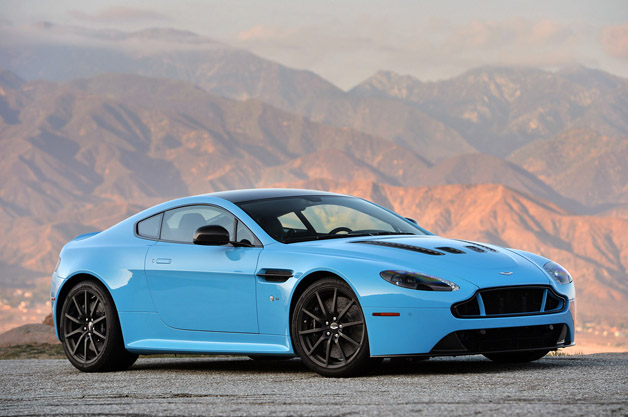
A little more than two years ago, I called the 2011 Aston Martin V12 Vantage “an intoxicating machine masterfully engineered to gratify every emotion in a car enthusiast’s soul.”
It wasn’t difficult to understand why, as the aluminum two-seater was like an old-school muscle car in its mechanical execution. While most of its competitors were boasting small-displacement engines with forced induction, the Aston Martin was fitted with a naturally aspirated 6.0-liter V12. While the others used sophisticated electronic dampers to maximize grip, the British automaker stuck with a fixed-rate setup. And, while nearly everyone in the industry was boasting automatic gearboxes, the V12 Vantage was still fitted with a slick-shifting six-speed manual. The coupe was not perfect, but it had tons of personality and it was a real kick to drive.
But now we have the V12 coupe’s successor, updated with an ‘S’ for the 2015 model year, and Aston Martin has altered some of the ingredients: the engine is more powerful, the suspension is electronically controlled and the gear changes are now automatic.
What effect does that have on a car that I once considered one of my favorites? I recently spent a long day with the sleek coupe to find out.
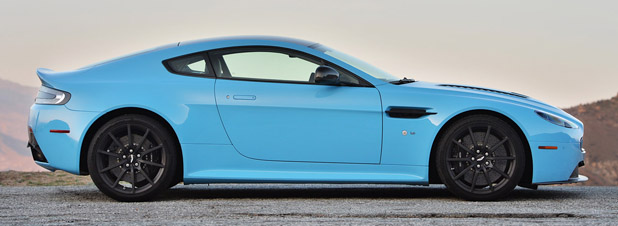

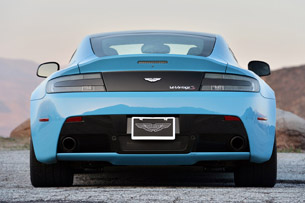
The V12 Vantage S first appeared on the scene in early summer when the British automaker boasted the arrival of “the fastest road-going Aston Martin yet.” After reading the press release, it was obvious that the team in Gaydon had taken advantage of an old racer’s old trick – they had dropped their most powerful engine into their smallest chassis.
Most observers will find it difficult to distinguish the 2015 model from last year’s car.
Like all Aston Martins today, the V12 Vantage S rides on an all-aluminum monocoque platform that the automaker calls its VH architecture. The lightweight framework is rigid and strong, and it is far from showing its age. While Aston offers the chassis with a variety of skins (the Vanquish features carbon fiber body panels), the Vantage S arrives with a mix of aluminum (doors, hood and roof) and composite (front quarter panels).
Most observers will find it difficult to distinguish the 2015 model from last year’s car, as the two appear nearly identical from anything more than 50 yards. The easiest way to differentiate it from its predecessor is to peer closely at the Aston’s signature front grille. While the outgoing car featured six horizontal aluminum vanes, the new models wear carbon fiber or titanium mesh with or without body color accents. The 10-spoke alloy wheels are also a fresh addition, and discriminating eyes may note a host of subtle changes to some of the trim and color combinations (e.g., a painted black roof is now offered).

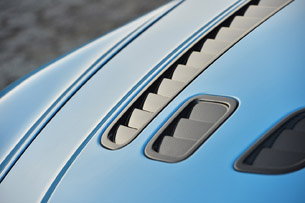
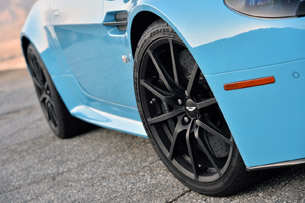

Aston hasn’t left the cabin alone either. Inside the cockpit, the standard chairs have additional Alcantara on the seating surface and revised stitching patterns. There is more upholstery detailing on the doors, and customers are offered more choices in terms of options (a new Carbon Fiber Interior Pack and lightweight sport carbon-fiber seats, for example).
It is the fastest street-legal sports car the company has ever sold – with the exception of the sold-out One-77.
The outgoing model was fitted with a naturally aspirated 6.0-liter V12, rated at 510 horsepower and 420 pound-feet of torque – it was the automaker’s strongest regular production engine at the time. Aston recently upgraded the powerplant, now called the AM28, with dual variable valve timing, larger throttle bodies, a revised intake manifold, fully machined combustion chambers and an improved fuel pump. The result is a solid bump of oomph to 565 horsepower at 6,750 rpm and 457 pound-feet of torque at 5,500 rpm.
While its predecessor was only available with a three-pedal, six-speed manual gearbox mid-mounted in the chassis, the new car loses the traditional transmission in favor of a standard Sportshift III AMT – a seven-speed, single-clutch automated manual transmission with electronic shift-by-wire controls. According to Aston Martin, the new V12 Vantage S will sprint to 60 miles per hour in 3.7 seconds and not run out of steam until it hits 205 mph (the V12 Vantage 6MT did the same run in four seconds flat and topped out at 190 mph). It is the fastest street-legal sports car the company has ever sold – with the exception of the sold-out One-77.
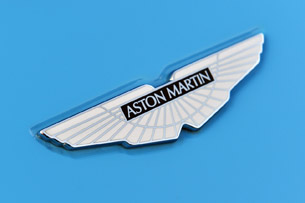
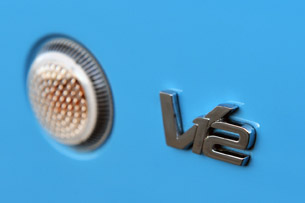
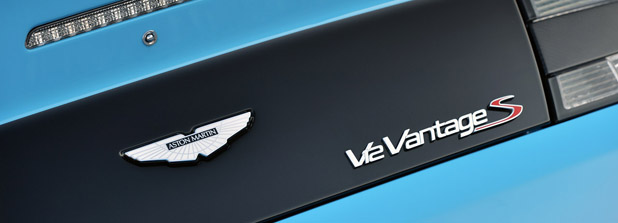
Another significant difference is found with the independent double-wishbone suspension. Last year’s V12 Vantage had fixed-rate dampers, but the 2015 model has been fitted with Aston Martin’s three-stage Adaptive Damping System (ADS). To adjust the damping, the driver uses a button on the top of the console to switch between three modes (Normal, Sport and Track), an action that also configures the amount of power steering assistance going through a new quicker-ratio ZF-Servotronic hydraulic system.
The 2014 model has been fitted with Aston Martin’s three-stage Adaptive Damping System (ADS).
The brakes are carried forward unchanged. Up front are massive ventilated/drilled carbon ceramic discs (15.7 inches in diameter) with six-piston calipers. The rear brakes are only marginally smaller ventilated/drilled carbon ceramic discs (14.2 inches in diameter) with four-piston calipers. The forged aluminum wheel size is unchanged, 19-inches in diameter, with each wrapped in a Pirelli PZero Corsa rubber (255/35ZR19 up front and 295/30ZR19 at the rear).
In the morning of the drive, Aston Martin handed me the keys to a Flugplatz Blue V12 Vantage S in the heart of Palm Springs, with instructions to meet for lunch at the Anza-Borrego Visitor Center. The destination was due south, about 50 miles away, with a mile-high range of mountains blocking the direct route. The circuitous drive to the desert would cover double the miles, but that was the automaker’s objective – much to my pleasure.
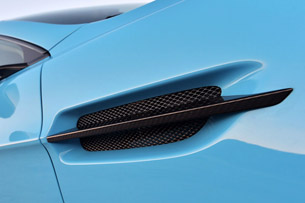
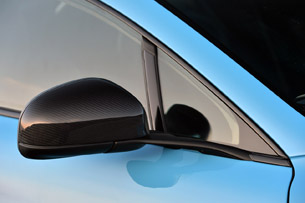
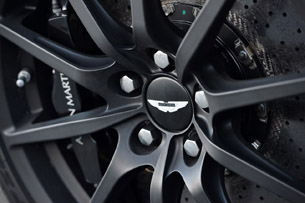
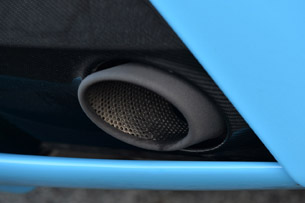
Sitting in the right seat was downright uncomfortable.
The seats have only been tweaked cosmetically over the years, meaning the driving position hasn’t changed. This meant my six-foot, two-inch frame fit comfortably in the driver’s seat and there was ample room for my legs, outstretched arms and plenty of headroom. Moving the seat into an agreeable driving position was easy, thanks to power-operated back and bottom cushions. Unfortunately, passengers won’t find the accommodations nearly as pleasing, as Aston Martin has not fitted an adjustable bottom cushion to their throne. This deliberate omission (blamed on the bulky occupant sensors that work with the airbags), combined with a shortened footwell that forces everyone’s legs to remain bent, meant sitting in the right seat was downright uncomfortable.
Unlike the Vanquish, which benefits from the upgraded instrument panel, the Vantage carries forward with the older Aston Martin cockpit that is best described as a smorgasbord of buttons, dials and switches. The layout is odd, and unfamiliar to the uninitiated, but someone who has spent some time sitting behind the wheel will know exactly how to reset the trip odometer (the small button to the right of the radio volume dial) and turn on the overhead dome lights (two small buttons just above the fan dial). It all makes sense. Well, eventually.
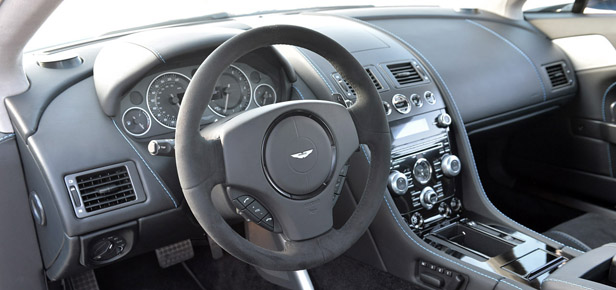
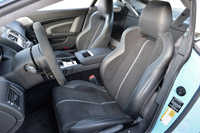
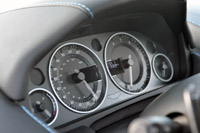
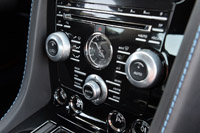
The 6.0-liter V12 roars to life, and then quickly settles into a silky idle.
Instantly understood, however, is the power emanating from under the aluminium hood after the crystal key is pressed into the center of the dashboard. The 6.0-liter V12 roars to life, and then quickly settles into a silky idle. I immediately pressed the Sport button, to the left of the key slot, and left its red LED illuminated the whole time. This control, common to nearly all Aston Martins, sharpens the steering, quickens throttle response and injects a bit more vitality into the transmission. Aston Martin uses glass buttons (RND) on the top of the console for selecting gears, with a hand-operated parking brake at the driver’s left thigh to hold the vehicle still when parked. Pull up and release on the brake, and then press the D button to get underway.
I’m no fan of single-clutch automated gearboxes because I have never come across one that works particularly well – and Aston Martin’s Sportshift III AMT makes no exception. Like similar systems from other high-end European rivals, the transmission is clunky and cumbersome around town and only becomes moderately bearable when shifted in manual mode with a slight lift before requesting the next-higher gear. Downshifts, on the other hand, are quick and smoothly executed by the automatic.
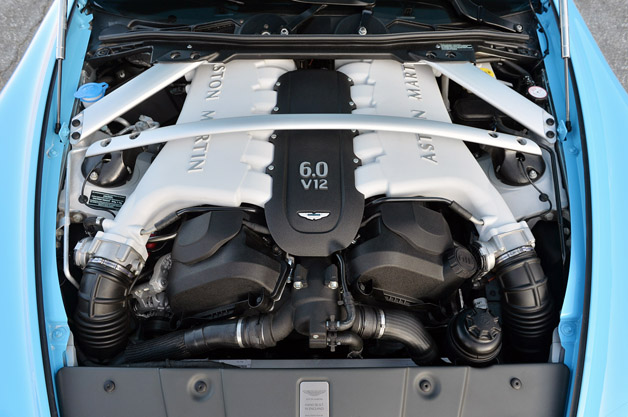
With 55 more horses at its disposal, the new V12 Vantage S finally runs with the fast players in the segment.
Transmission quirkiness aside, the V12 is a jewel of a powerplant. Naturally aspirated engines are a dying breed, and Aston Martin still makes one of the best on the market. Spinning the tachometer needle counter-clockwise around its dial is an effortless exercise when the accelerator pedal is planted, and the force at the backside is accompanied by a wondrous exhaust note from the twin pipes. Last year’s V12 Vantage was plenty quick, but with 55 more horses at its disposal, the new V12 Vantage S finally runs with the fast players in the segment. The seat-of-the-pants difference between the two vehicles is extraordinary.
And the Aston will have no trouble keeping up in the corners either. The adaptive damping delivers a tailor-made ride customized for the road surface. Part of my route included Montezuma Valley Road (County Highway S22), which culminates with a spectacular curvy drop to the desert floor. Its fresh asphalt is glass smooth, so I switched to Sport mode for the descent. Later in the afternoon, when traversing broken decades-old asphalt, I switched back to the softer setting and was rewarded with a noticeably improved ride. The new steering may give up a tiny bit of sensitively compared to the old system, but I found little to complain about. It felt accurate, stable, nicely weighed and mechanically connected to the front wheels (that can’t be said about some of today’s new electrically boosted units).
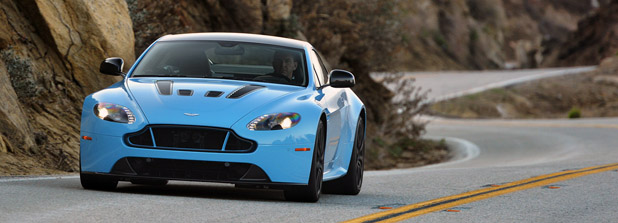
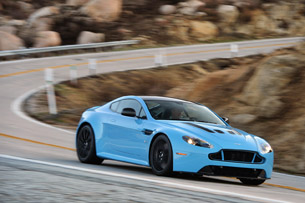
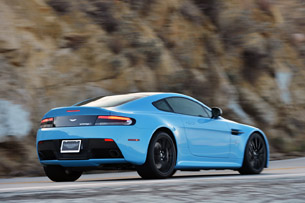
Nothing short of a race track is required to exceed its cornering capabilities – posted legal speeds won’t even warm its tires.
Pirelli Corsa rubber is considered by many nothing more than a street-legal grooved slick, and its treadwear rating of just 60 (most high-performance summer tires are in the 140-200 range) promises plenty of grip at the expense of longevity. Nevertheless, I’d stick with them for the ownership duration as their meaty contact patches allowed the V12 Vantage to corner at obscene levels. The coupe is low and wide, and it hunkers down with a solid demeanor when coaxed into a curve. With its first-rate tire and adaptive suspension combination, nothing short of a race track is required to exceed its cornering capabilities – posted legal speeds won’t even warm its tires.
Another part of the car that isn’t fully utilized on US public roads is the carbon-ceramic brakes, which are designed to absorb the energy from blistering 200-mph stops. I pounded them hard at speed, multiple times, just to see how they reacted. They responded consistently, hauling the two-seater down to a stop without any unnecessary wandering, drama or fade. Early carbon brakes were fraught with compromise, including lackluster stopping power when cold and an annoying noise. Not anymore.

It is by all counts a tremendous sports car.
Including the round trip drive from Palm Springs to the desert, and adding in a few more hours for off-site photography, I put about eight hours in the driver’s seat and burned an entire tank of premium unleaded (it holds slightly more than 21 gallons). While most of it was with a heavy right foot, dancing between the accelerator and brake pedal, there were also long periods of steady cruising at highway speeds. It was an excellent drive – one that let me put the talented Brit though its paces.
Overall, the Aston Martin left me speechless with its gorgeous styling and dazzled by its brilliant performance – strong praise, indeed – and it is by all counts a tremendous sports car. But, to answer my original question, does the new version remain one of my favorites?
Dropping the beloved manual gearbox (it really was a gem) and replacing it with a mediocre single-clutch automated transmission was a painful blow in the eyes of this enthusiast, but it doesn’t appear to have crippled the new car when considered as a complete package. In fact, from the driver’s seat, the V12 Vantage S emerges with more capability than ever before. A glance at its performance, or a stint behind the wheel, reveals that the S model is quicker, faster and more agile than its predecessor could ever be. And with the welcomed cosmetic enhancements, additional luxury and new technology, I am led to believe that few in this rarefied segment will ever miss the effort of rowing their own gears.
UPDATE: Aston Martin has informed us that the new V12 Vantage S will actually be sold as a 2015 model year vehicle, rather than a 2014 model.
Engine: 6.0L V12
Power: 565 HP / 458 LB-FT
Transmission: 7-Speed SCT
0-60 Time: 3.7 Seconds
Top Speed: 205 MPH
Drivetrain: Rear-Wheel Drive
Curb Weight: 3,560 LBS
Seating: 2
Base Price: $184,995
As-Tested Price: $209,690
.


While we mourn the loss of yet another row-your-own option in a supercar, the new paddle-shifted gearbox offers two distinct advantages over the obsolete six-speed. The new transmission is a whopping 55 pounds lighter, and it helps translate the 5.9-liter’s extra 55 ponies into a top speed of 205 mph—up from a redline-limited 190 mph in the previous V12 Vantage.
Thanks, please share